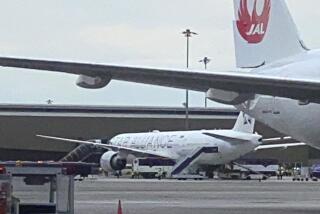Spy Plane Seeks Bumps in the Air
YOKOTA AIR BASE, Japan — Pilot Noel Roediger has been getting his plane to do some strange things at 42,000 feet. Like flying backward. Or at a ground speed of zero.
And it’s all for science.
Roediger has been flying a modified spy plane into the jet stream off Japan’s east coast in search of the worst turbulence he can find as part of a study scientists hope will shed light on the nature of turbulence and ways for aircraft to avoid it.
“Many pilots have a false sense of security about turbulence,” said Roediger, who flew commercial jets for more than 30 years for an Australian airline.
“But, if you’re not prepared,” he said, “it can be like being in an elevator when the cable breaks.”
The skies off Japan’s east coast were chosen because they are among the most turbulent in the world. The U.S. Air Force funds the study, which uses a plane owned by Australia’s Flinders University.
Each year, turbulence injures at least several dozen airline passengers.
In January alone, five people were injured when a Tokyo-bound United Airlines jumbo jet from Chicago hit severe turbulence. Ten days later, 22 were hurt when a Continental Airlines flight from Tokyo to Honolulu hit severe turbulence.
Though usually more of a nuisance than anything else, turbulence can be deadly. The most recent fatality on a U.S. airline, for example, wasn’t the result of a crash but of turbulence that jolted a United flight from Tokyo to Honolulu in December 1997. One woman died and 100 other passengers were injured.
Owen Cote, chief scientist for the project, said the rough skies off Japan are the result of the convergence of several factors, including the meeting of hot and cold air and the curvature and spin of the Earth itself.
Along with Japan’s, the skies over Hawaii are also particularly turbulent.
When the fastest winds in the jet stream slow down, upward motion tends to be created--and that can cause the turbulence problems faced by pilots, commercial and military. Airflows over mountains and the heating of land masses during daytime are other causes of turbulence.
“It’s a very complex phenomenon of the atmosphere,” Cote said. “There is a lot that we don’t know and that has never really been measured before.”
To measure turbulence and other upper atmospheric conditions, the project’s German-built Grob Egrett airplane is equipped with sensors for air temperature and humidity, pressure, winds and trace gases.
Sensors about the size and shape of a baseball bat stick out of its wings and tail. The plane’s exact position in flight is closely monitored.
Roediger and mission scientist Jorg Hacker, an assistant professor at Flinders, which is in Adelaide, Australia, have been flying the turbulence-seeking missions out of Yokota Air Base on the outskirts of Tokyo.
Because they fly so high, about 10,000 feet higher than commercial airliners, they must wear full oxygen masks and clothing to protect them against extreme temperatures.
But the wind is the real concern.
“We fly into winds upward of 230 miles per hour,” Roediger said. “The winds are so strong, you can plant your plane in there and you’re stationary. We’ve even flown backward.”
Even so, Hacker said the plane--originally designed for high-altitude reconnaissance flights over East Germany--is so aerodynamically sound that it’s usually a smooth ride.
“You feel the turbulence, but it’s not as bumpy as in a jetliner,” he said. “It’s quite benign.”
Hacker said a better understanding of the basic physics involved could help scientists create computer simulations and improve forecasts of turbulence. He said the group is also one of many developing a laser device for pilots to detect turbulence early enough so that it can be more effectively avoided.
None of this is likely to mean quick relief for nervous fliers, however.
“What we are doing is basic research,” Hacker said. “We may not be able to apply our findings tomorrow, but the measurements we are taking will help us understand the physics of the atmosphere and of turbulence.”
More to Read
Sign up for Essential California
The most important California stories and recommendations in your inbox every morning.
You may occasionally receive promotional content from the Los Angeles Times.










